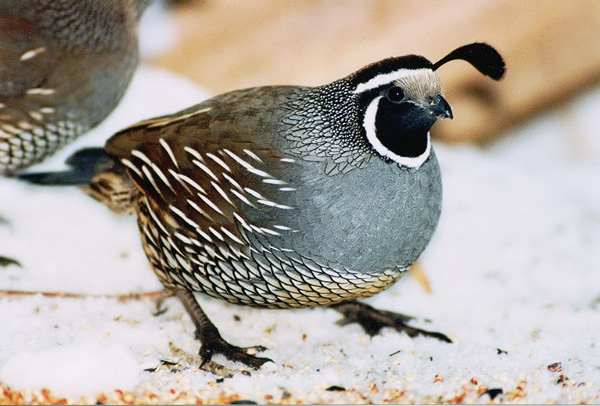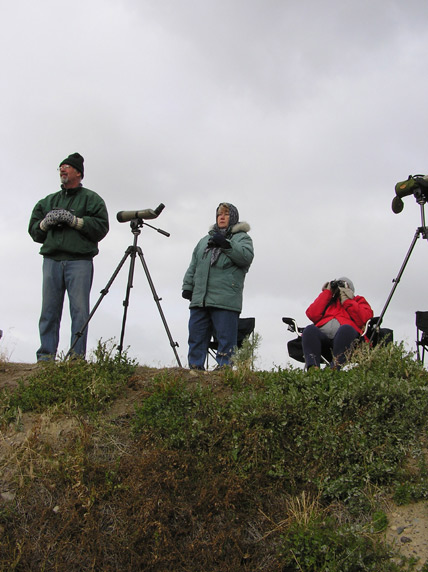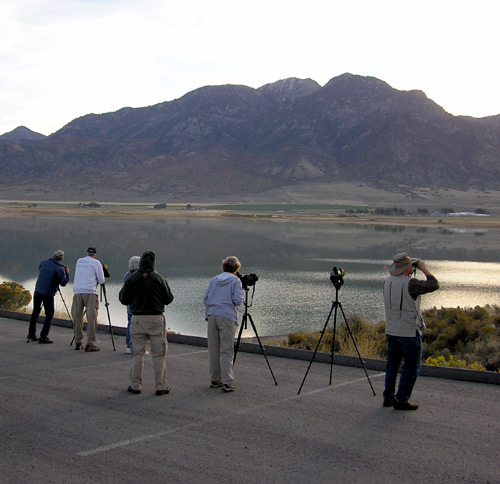Utah County Birders Newsletter
|
 |
|
California Quail - photo by Paul Higgins |
Bird of the Month
California Quial
Callipepla californica - California’s
state bird
by Gayla Muir
In one of my first Utah County Birder’s meetings we were asked to share what
bird “hooked” us on birding. Mine was the California Quail. I have always had a
family of quail live in my bushes and love watching them wander back and forth
to their feeding areas with chicks in tow.
The geographic range for the California Quail is the Western United States,
British Columbia, Chile and New Zealand and can be found in the Pacific coast
region of the United States. Its original range stretched from Baja California
to a small portion of Western Nevada and the southern counties of Oregon. The
California Quail is kept as a pet and is favored as a game bird. Because of
this, it has been successfully introduced to other regions of the United States
such as Northern Nevada, New Mexico, Hawaii, and Utah. They do not migrate and
tend to spend their entire lives in an area usually two miles in diameter.
California Quail prefer living in open woodlands, bushy foothills, valleys with
streams, and suburbs. They can also live in brush land and agricultural land.
Their primary diet consists of seeds, grains, and nuts. If available they eat
fruits, berries and insects. Maximum movements have been recorded up to 16.8
miles, their timed flight is 38 - 58 miles per hour, and their ground speed has
been timed at 12 miles per hour. Predators are hawks, owls, coyotes, bobcats,
foxes and feral/domestic cats. They rarely venture more than 50 feet from
safety. They are a sedentary bird. After their morning feeding they retreat to a
dense cover and rest until evening feeding.
The California Quail are members of the Phasianidae family. These are
stout-bodied birds like the turkey, pheasant, grouse and partridge family with
strong feet and legs designed for life on the ground. Their average weight is
between 5 - 7 ounces. Males are slightly heavier. An adult grows to be 9.8
inches in length. They have a distinctive black and white pattern on the face
and the belly has black and brown feather tips which makes it look like it has
scaled underparts. The overall color is blue-grey and brown. The crown is
chestnut colored with streaking along the sides, they have black bills and grey
legs, and sexes are dimorphic. The males have a black throat and the females
have more of a greyish colored throat with black streaks. California quail can
be identified by their prominent teardrop-shaped plume on the forehead. Immature
California Quail have general coloration of mostly greys and browns. Their vocal
repertoire includes at least 14 different sounds.
In the fall, they are quite social and travel in small groups (or coveys)
typically ranging from 25 to 40 birds, but coveys in excess of 1000 have been
reported. In Spring, when mating and nesting season starts, coveys disintegrate
as individual birds begin to pair up and males defend territories as well as
their monogamous mate. After pairing they find a well hidden area so they can
prepare their scrapes.
The most typical time for reproduction is during May, June, and July. If they do
not successfully nest on their first attempt, they make a second nesting attempt
later in the summer. Their nests are made in shallow scrapes in the ground lined
with grass. They can lay from 6 to 28 eggs, with the average being 13 - 17. Eggs
are pointed ovals and are creamy white in color with light golden brown spots.
Females incubate the eggs 22-23 days with the male close at hand to tend her. In
the event of the female’s death, the male may assume incubation duties. Chicks
hatch synchronously and begin running about within an hour. The male is
considered a model husband and father. He boldly performs the risky role of
sentry, flying high to an exposed perch standing guard watching for and alerting
his family to danger. Their chicks grow rapidly and after two weeks they are
ready to fly short distances. They remain with their parents through the winter
where family groups come together once again to form coveys.
 |
|
Milt, Tuula and Bonnie helped with the morning shift - photo by Eric Huish |
The Big Sit - Provo Airport Dike 12 Oct 2008
by Eric Huish
I brushed an inch of snow off my car early Sunday morning and headed to the
Provo Airport Dike. The storm missed the dike. There was no snow on the ground
and although there were storm clouds threatening us all day we only saw three or
four snowflakes. The sun broke through the clouds late in the afternoon giving
us great lighting on the mudflat. It was cold ( in the 30s with a breeze) all
day long and we ended the day with one of the lowest species counts we've had on
a big sit. It was still great fun.
This year the count circle was occupied by at least one person all day from
before dawn to dusk (6:15 a.m. to 7:30 p.m. - 13 hours). We saw 45 species. Most
exciting bird was a Stilt Sandpiper mingling with the many dowitchers that spent
the day on the mudflat. Other good birds included 5 Mountain Bluebirds, a
Merlin, and two Pectoral Sandpipers. Mountain Bluebird, Coopers Hawk and Stilt
Sandpiper were all new for our 'Big Sit Life List', which after 7 years is now
at 104 species.
Thanks to all the participants - Ned Bixler, Georgiana Deming, Eric Huish, Benji
Martineau, Keeli Marvel, Milton Moody, Cheryl Peterson, Susan Powell, Rachel
Rollins, Tuula Rose, Bryan Spencer and Bonnie Williams.
Species List - Canada Goose 20, Mallard 6, Green-winged Teal 1, Ring-necked
Pheasant 1, Pied-billed Grebe 2, Great Blue Heron 2, White-faced Ibis 1,
Northern Harrier 2, Cooper's Hawk 1, Red-tailed Hawk 2, American Kestrel 2,
Merlin 1, American Coot 2, Sandhill Crane 2, Killdeer 125, American Avocet 2,
Greater Yellowlegs 7, Lesser Yellowlegs 6, Pectoral Sandpiper 2, Stilt Sandpiper
1, Long-billed Dowitcher 230, Wilson's Snipe 3, Ring-billed Gull 45, California
Gull 2, Rock Pigeon 50, Belted Kingfisher 1, Downy Woodpecker 1, Northern
Flicker 2, Black-billed Magpie 3, Tree Swallow 1, Barn Swallow 28, Black-capped
Chickadee 1, Marsh Wren 3, Mountain Bluebird 5, American Robin 26, European
Starling 18, American Pipit 30, Yellow-rumped Warbler 4, Spotted Towhee 1, Song
Sparrow 1, White-crowned Sparrow 2, Red-winged Blackbird 40, Yellow-headed
Blackbird 2, Brewer's Blackbird 25 and House Finch 3.
 |
|
Utah County Birders at Mona Reservoir - October 18, 2008 - photo by Eric Huish |
Mona and Goshen Valleys - 18 October 2008
by Alona Huffaker
October 18 proved to be a very enjoyable day to birdwatch in Juab and Utah
Counties. Yvonne and Burt Carter, Grant Jense, Lynn Gardner, Eric Huish, Ned
Bixler, Dave Hanscom, Bonnie Williams and Alona Huffaker were led on this outing
by Lu Giddings. We went by way of Santaquin to Mona Reservoir, then through
Goshen Canyon and out through the area south of Elberta, north of Goshen and to
Warm Springs area. We saw Canada Geese, American Wigeon, Mallard, Green-winged
Teal, Canvasback, Ruddy Duck, Ring-necked Pheasant, Common Loon, Pied-billed
Grebe, Western Grebe, American White Pelican, Great Blue Heron, Northern
Harrier, Red-tailed Hawk, Ferruginous Hawk, American Kestrel, Merlin, American
Coot, Franklin's Gull, Ring-billed Gull, California Gull, Eurasian Collared
Dove, Northern Flicker, Common Raven, Horned Lark, Bewick's Wren, Ruby-crowned
Kinglet, European Starling, American Pipit, Yellow-rumped Warbler, Song Sparrow,
Lincoln's Sparrow, White-crowned Sparrow, Dark-eyed Junco, Red-winged Blackbird,
Western Meadowlark, Brewer's Blackbird, Brown-headed Cowbird, and House Sparrow.
The Pelicans were in a huge flock of about 200 flying away off to the
south--pretty neat looking! We did see a Great-horned Owl, but it was dead with
no signs of being shot--poor thing. (Although it did give us a chance to look at
it closely.) We also saw a fox, some deer (and hunters since it was opening of
the deer hunt!) and some duck hunters that thought they were doing a good
imitation of a duck call---they weren't!
Backyard Bird of the
Month
October 2008
Steve Carr - Holladay
Dark-eyed Junco - Lots of them; I see more in my yard in winter than I
ever do in the mountains in summer.
Lynn Garner - Provo
Black-capped Chickadees checking out the nyjer in my stocking feeder.
Alona Huffaker - Springville
Four Evening Grosbeaks flew over my yard.
Eric Huish - Pleasant Grove
Chipping Sparrow - at my platform feeder on my windowsill on Oct 1st. I
don't often get chippers in my yard.
LeIla Ogden - Orem
A beautiful American Kestrel looking over my feeders.
Reed Stone - Provo
American Dipper and Canada Goose near my riverside deck.
Bonnie Williams - Mapleton
Spotted Towhees - Two at once.
We would like you to share your favorite backyard bird each
month. Please send your favorite bird at the end of the month to newsletter@utahbirds.org
or call 360-8777.